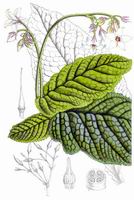
Bot. Mag. t. 6484 (1868).
Full name and orig. publication: Conandron Sieb. & Zucc., Abh. Math.-Phys. Cl. Königl. Bayer. Akad. Wiss. 3: 729, t. 5 (1843).
Etymology: From the Greek κωνος, kōnos = cone, and άνδρών, andrōn = part of the antique house in which men acted in seclusion from the women. The anthers form a distinct cone in that the margins are fused and have an elongated apical appendage.
Synonyms: -
Infrafamilial position: Didymocarpoid Gesneriaceae - "Advanced Asiatic and Malesian genera" (Weber 2004).
Description: Perennial (sub)acaulescent herbs. Leaves few, in a basal rosette, (sub)glabrous, lamina elliptical with cuneate, truncate or cordate base. Cymes axillary, few- to many-flowered, lax. Sepals free nearly to base, equal. Corolla actinomorphic, glabrous, tube c. half as long as limb, limb 5-lobed, lobes equal, acute or obtuse. Stamens 5, inserted near corolla base, exserted; anthers dorsifixed, connate into a tube surrounding the style; thecae parallel, apically not confluent, longicidally dehiscent; connectives with long apical projections. Nectary lacking. Ovary ovoid, with parietal placentae; stigma globose, undivided. Capsule straight, narrowly ovoid, c. 2,5 x longer than calyx, loculicidally dehiscent.
Chromosome number: 2n = 32.
Type and only species: Conandron ramondioides Sieb. & Zucc.
Species names (incl. publication and synonyms): See Skog, L.E. & J.K. Boggan. 2005: World checklist of Gesneriaceae: http://persoon.si.edu/Gesneriaceae/Checklist.
Distribution: S Japan, E China (N Fujian, Zhejiang, NE Jiangxi, S Anhui), Taiwan.
Ecology: Humid and wet rocks in forests, 500 - 1300 m.
Notes: The genus is notable for the actinomorphic flowers and anthers with apical appendages.
Selected references: Wang et al. in Wu & Raven, Fl. China 18: 250 (1998).
Bibliography: See Skog, L.E. & J.K. Boggan. 2005. Bibliography of the Gesneriaceae. 2nd edition: http://persoon.si.edu/Gesneriaceae/Bibliography.
Illustrations:
 |
Conandron ramondioides Sieb. &
Zucc. (white-flowered form)
Bot. Mag. t. 6484 (1868). |
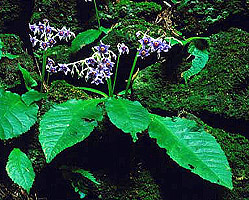 |
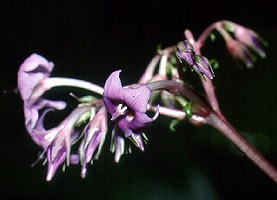 |
Conandron ramondioides Sieb. &
Zucc.
Left: Japan, Tokyo, Mt. Takaosan, phot. G.
Kokubugata (2002) |
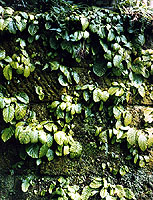 |
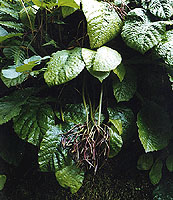 |
Conandron ramondioides Sieb. &
Zucc.
Japan, Tokyo, plants growing on a temple wall, note pendent infructescence (right), phot. Jill Harrison |
last modified: 2007-07-13